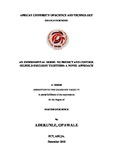| dc.description.abstract | Formation of water-in-oil emulsions are among the major challenges encountered by production and surface facilities engineers during the recovery of crude oil, especially in a large multi-wells system in both onshore and offshore oilfields. The development of systematic approaches to handle emulsion problem has been very slow. Several important aspects of emulsion that have not being studied extensively to date include mechanism, kinetics and energy levels associated with emulsion formation. Such information is needed to understand the emulsification process, model it and hence solve lots of operational and economical emulsion issues.
This study presents a novel experimental approach to model the process of water-in-oil emulsion formation and also study the shearing energy levels associated with its formation.
Oilfield emulsions were simulated using agitator rated between 0 to 1000 RPM. Mixture of crude oil, formation water, asphaltene, inorganic solid, scale precipitates and reservoir fines were agitated at various revolutions to form the emulsion. The emulsions that result were stabilized using re-solubilized asphaltene precipitated out of the crude oil.
A demulsifier chemical sample was used to properly treat over 300 bottle samples, and the rate of separation of their emulsified water was used to determine their tightness. Relationship between shearing energy at the wellhead chokes, pressure drop across it, and its size was first developed. This equation relates the production rate, type of the crude oil produced and the nature of the choke during production to shearing energy.
The results from the experiments show that increase in the fraction of the dispersed water phase in an oil- water mixture, leads to formation of tight emulsions. This relationship existed until the point of inversion from water/oil emulsion to oil/water emulsion is reached at 60% watercut, and loose emulsions will start forming. Also asphaltene was seen to contribute tremendously to the formation of tight emulsions. At 2.9% concentration of asphaltene the emulsion becomes more difficult to treat, with a tightness of 18 %. Inorganic solids-sodium bentonite and calcite demonstrated little effects on emulsion stability. Further studies were carried out to study the wettability effect of asphaltene on the inorganic solids and consequently their stabilizing effect on emulsion. Result shows that these solids behaved as very strong emulsifiers when coated with asphaltene. Results from the second set of experiment shows that shearing energy, asphaltene concentration and water-oil-ratio are major factor that determines the formation of tight emulsion. A particular shearing energy threshold (SET) value is needed to form emulsion for a specific water oil ratio, regardless of the concentration of asphaltene present.
Lots of interesting trends relating watercut, asphaltene content and shearing energy are seen from the results in this study, and hence could be used to predict and rank emulsion samples according to their tightness. The emulsion diagnostic plots (EDP) produced were digitized and best line of fit for each of the data series plotted was gotten and their corresponding equations generated. These equations were then developed into a java executable application, EMULS-K. This application was used to analyse the emulsion problem in an oilfield of a major operator in Niger Delta. EMULS-K program generated values of emulsion tightness (ET) for all the 21 wells in this field and hence spotted out the problematic ones. The result obtained from this analysis correlates perfectly well with those gotten by a service company using the old bottle test approach. | en_US |

